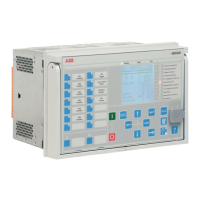crosswise. This requires an extra logic where dual-point command bits have to be
converted, that is, 0=>0, [01]=1=>[10]=2 and [10]=2=>[01]=1.
M/F is the only parallel mode which has an out-of-step functionality. In the MCC and
NRP operation modes, the circulating current is minimized, which most probably
means different tap positions in the parallel transformers. Moreover, these modes
allow different ratings and step voltages for the parallel transformers. Therefore, it
is reasonable to apply the out-of-step function only to the M/F operation mode.
The out-of-step function is triggered when the master detects a difference of at
least one step between the tap changer positions in the follower and in the master.
The master then sends special raising or lowering commands to the diverged
follower. If two consecutive commands fail to change the position of the follower
to the right direction, the master activates the PAR_FAIL output, that is, PAR_FAIL
is set to TRUE, and stops the special recovery efforts. However, every time the
master controls its own tap changer later, it always sends a controlling pulse to
the diverged follower too. Furthermore, if the master notices a correct position
change after a sent pulse, it restarts the attempt to drive the follower to the
same position and deactivates the PAR_FAIL output, that is, PAR_FAIL is set to
FALSE. However, if there still are diverged followers, the reset is not indicated.
It is indicated only when no diverged followers exist. Monitoring, and hence the
indication of a paralleling failure, is not possible in blind control. The followers with
a parallel failure can be read from the monitored data FAIL_FLLW. For example, if
only follower 3 is in the parallel failure state, FAIL_FLLW has the value "Follower 3".
If both followers 1 and 2 are in the parallel failure state, FAIL_FLLW has the value
"Followers 1+2". By default, when no failed followers exist, the value is "No failed
followers".
Negative Reactance Principle NRP
This parallel control scheme is suitable for power transformers with different
ratings and step voltages. Since no communication between the regulators is
needed, this principle can be applied even when the parallel transformers are
located at different substations. To start the parallel operation, the acting
operation mode has to be set to "NRP" for all the regulators of the connection.
The acting operation mode can be changed via function block inputs or by setting
either locally or remotely.
When applying this principle, each regulator has a phase angle setting φ
Load
(setting parameter
Load phase angle
) towards which it tries to regulate the current.
The setting value is chosen according to the expected power factor of the load
(positive setting value equals inductive load). When the actual phase angle of the
load current is the same as the setting and the transformers and their tap changer
positions are identical, the currents of the two or more transformers are in the
same phase as the total load current. If the tap changer positions are different, the
circulating current flows and the currents of different transformers either lag or
lead the load current.
Figure 561
shows that the circulating current is the reactive
component which separates the measured current vector from the expected angle
value.
Control functions
1MRS757644 H
1056 620 series
Technical Manual

